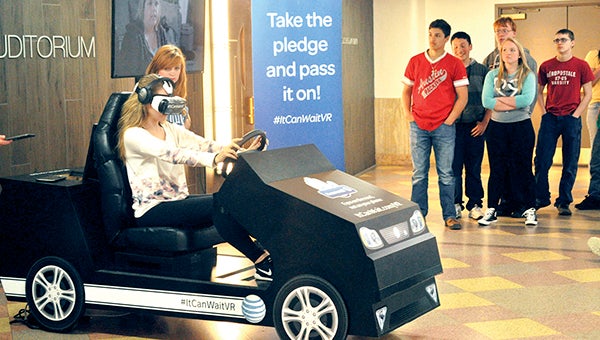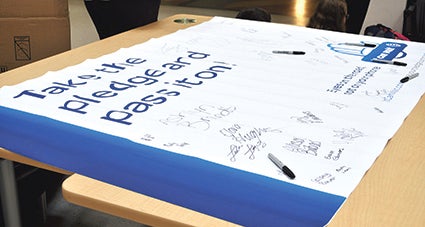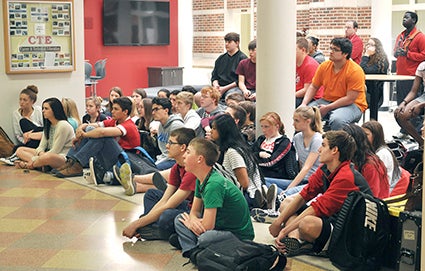An ‘eye-opener’; Simulator shows AHS students the dangers of distracted driving
Published 11:15 am Wednesday, May 18, 2016

Sophomore Lydia Morey experiences the virtual reality distracted driving simulator at AT&T’s campaign It Can Wait at Austin High School on Tuesday. Morey said “the simulator really affected her.” — Photos by Jordan Gerard/jordan.gerard@austindailyherald.com
Austin High School students texted while driving Tuesday, but in a safe setting to learn about the potential dangers of distracted driving.
AT&T and the Minnesota Safety Council’s national campaign It Can Wait program visited AHS to talk to the students about the dangers of distracted driving.
Valerie Bruggeman, director of external affairs at AT&T Minnesota, said they want to change the behavior around distracted driving.
“We have seen the education continue to help change the behavior,” Bruggeman said. “The hope is to change the behavior.”
Students got to use virtual reality goggles that played a simulation of driving and receiving text messages or getting distracted by things inside and outside the car. They were able to control the virtual vehicle with a steering wheel and gas pedals.

Austin High School students signed a pledge not to text and drive at the AT&T It Can Wait campaign on Tuesday. The pledge can also be made online.
Junior Garett Ruroden said he was shocked when he was in the simulation.
“It was an eye-opener,” he said. “The last text is not worth dying for at all.”
Ruruoden said he was trying his best to drive in the simulator but that it only took a second for the car to hit something or someone.
“It was hard to concentrate on driving while text messages were coming in,” Ruroden said.
He added he wasn’t as aware of the dangers before the campaign but he is more aware now.
AHS Principal Katie Baskin said the school was happy to host the simulator to draw awareness to this important issue.
“In today’s connected society, many drivers are focusing on their phones to text, email and even video chat when they should be concentrating on the important task of driving,” Baskin said in a press release. “We want to help keep our students at Austin High School safe by educating them on the dangers of smartphone activities behind the wheel.”

Austin High School students watch a PSA about the dangers of distracted driving on Tuesday. AT&T is hosting a nationwide campaign to change behavior towards distracted driving.
The “It Can Wait” campaign is a year-long tour around the United States, Bruggeman said. It focuses on educating students who have their license or are just learning to drive.
The campaign also showed public service announcements about texting and driving. Included in the PSAs were real stories of people who lost loved ones to accidents caused by texting and driving.
Sophomore Lydia Morey said the simulation was powerful.
“It really affected me,” she said. “It shows how powerful those last seconds are.”
Students could also sign a banner that will be displayed in the school saying they took the pledge to not text and drive. The pledge can also be signed online. More than eight million people have already signed it.
AT&T launched the campaign in 2010.
Distracted driving statistics
• 7 in 10 drivers use their smartphone will driving
• 4 in 10 drivers use social media
• 25 percent are on Facebook
• 1 in 7 are on Twitter
• 3 in 10 surf the net
• 1 in 10 video chat
Numbers provided by AT&T





